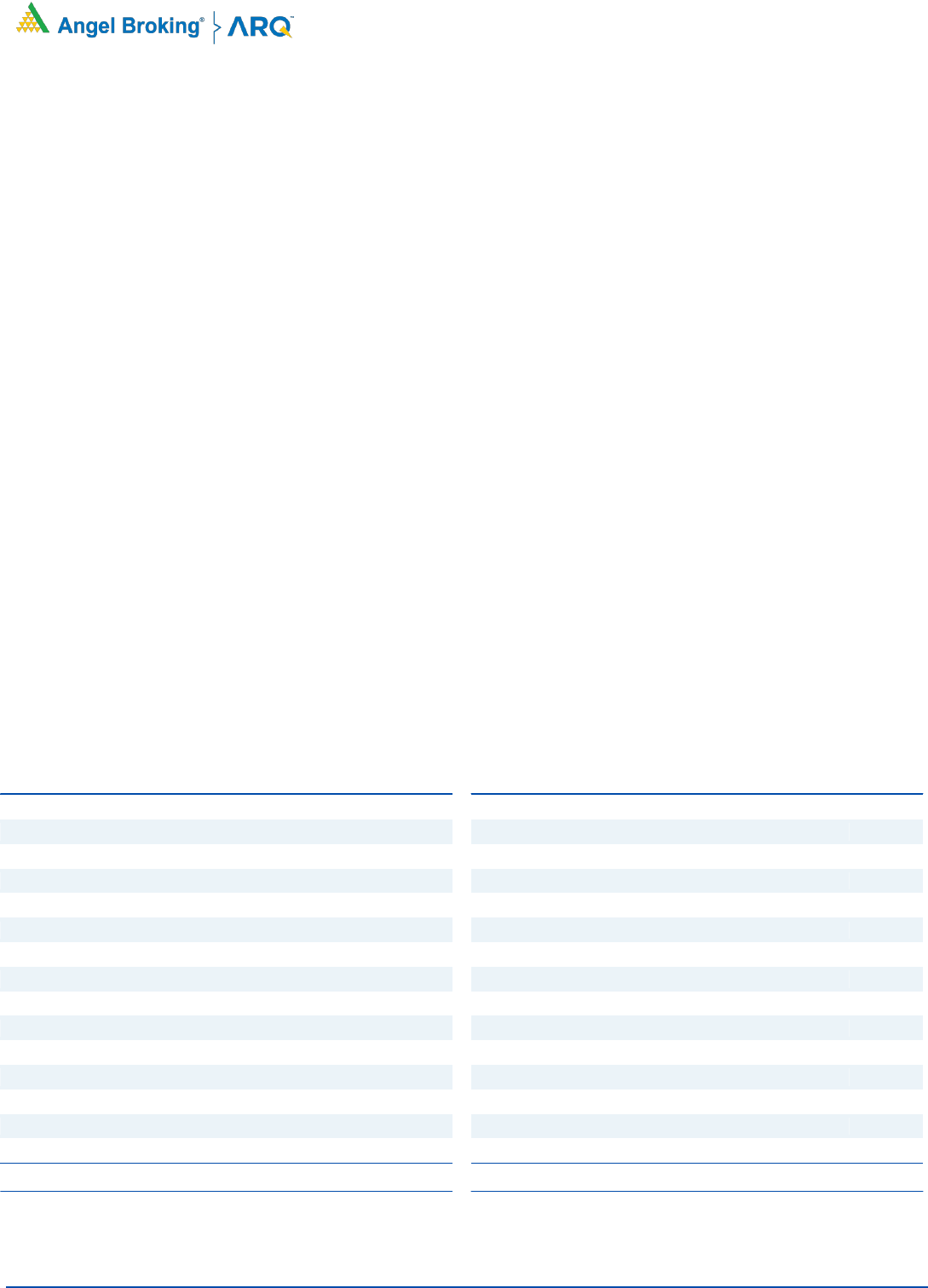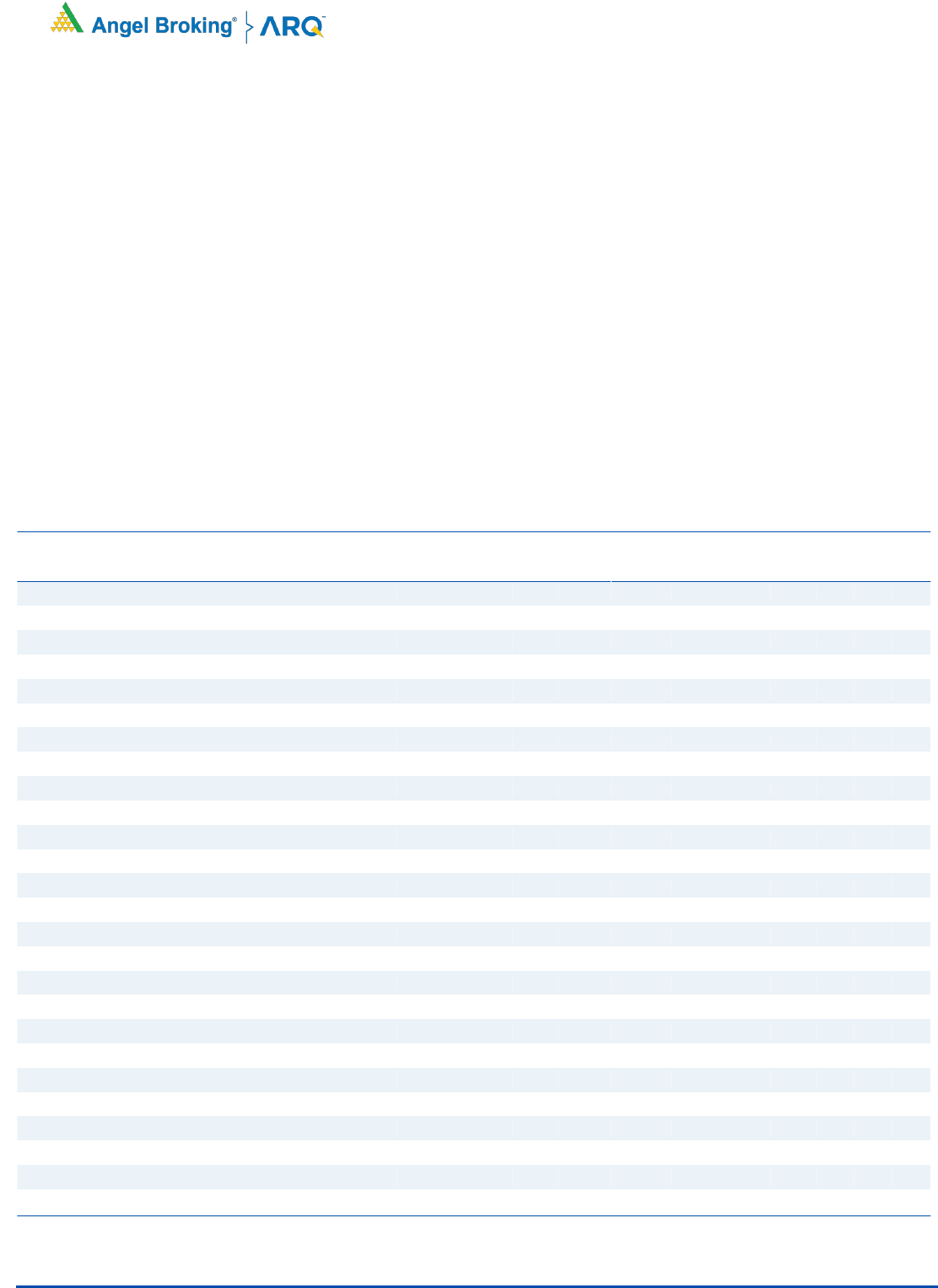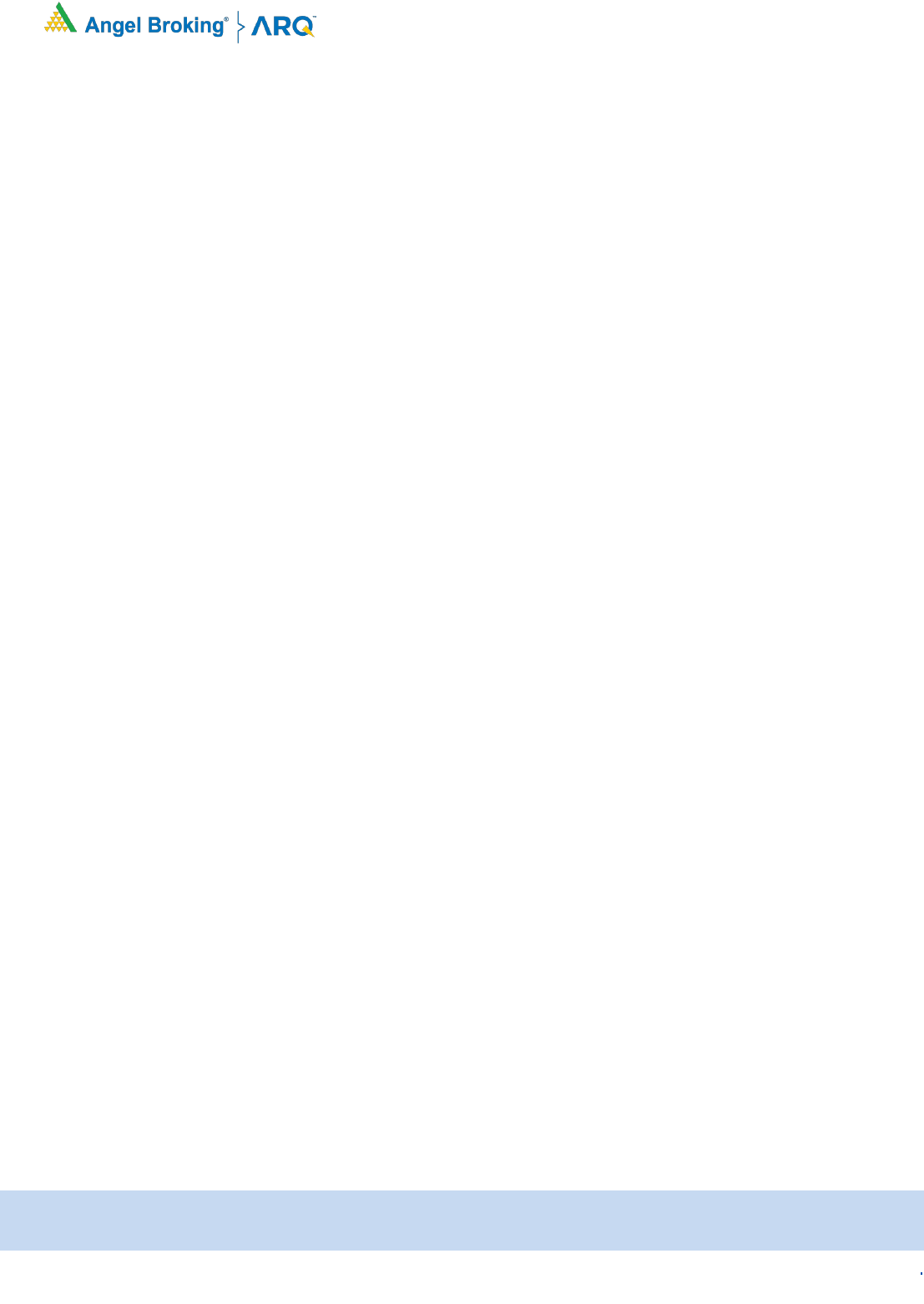
1
Please refer to important disclosures at the end of this report
1
1
Update on Government stimulus – Part II
Size of economic stimulus announced is below market expectations
The Finance minister has announced an economic stimulus package of ` 11 lakh
cr. between the 13
th
and the 17
th
of Mar’20. Including various measures
announced by the RBI & government earlier total size of the economic package
works out to INR 21 lakh cr. Markets have however been disappointed by the
package given that it relies more on providing credit to the markets and the lack of
actual cash spending and far reaching reforms by the Government.
Other than the lack of cash spending the markets have also been disappointed by
the size of the new measures announced as it is also includes liquidity measures of
` 2.8 lakh cr. announced by the RBI prior to the 27
th
of Mar’20 which was not in
line with market expectations.
Increased borrowing limits for states linked to structural reforms
However there are some key proposals in the form of structural reforms in
Agriculture and power sector which would be very positive for the economy in the
long run. The Government has said that it will amend the essential commodities
act and also undertake long standing demand for agriculture market reforms
wherein Agriculture food stuffs including cereals, edible oil, oilseeds, pulses,
onions and potato will be deregulated.
The Government has also accepted state governments demand for increase in
their borrowing limit to 5% of Gross State Domestic Product (GDSP) from 3% of
GDSP for FY2020-21 in order to make up shortfall in revenues due to economic
slowdown. However only 0.5% increase in borrowing limit will be unconditional
and the balance of the additional borrowing limits will be linked to specific reforms
in the areas of universalisation of ‘One Nation One Ration card’, Ease of Doing
Business, Power distribution and Urban local body revenues.
Exhibit 1: List of announcement in stimulus 2.0 (` cr.)
Collateral free Govt guaranteed loan for business\MSME
300,000
Concessional credit to farmers through PM KISAN card
200,000
Fund for strengthening farm gate infra
100,000
Liquidity support for DISCOM
90,000
Credit linked subsidy scheme for real estate
70,000
Equity infusion for MSME through FoF
50,000
TDS/TCS reduction
50,000
Partial credit guarantee scheme for NBFCs
45,000
Additional MGNREGA allocation
40,000
Standing liquidity facility for NBFCs/HFCs/MFIs
30,000
Additional Funding for farmers through NABARD
30,000
Subordinate debt for stressed MSME
20,000
PM Mastya sampada yojna
20,000
Animal husbandry infra development fund
15,000
Other Measures
42,650
Total
1,102,650
Source: Company, Angel Research
Exhibit 2: Total stimulus so far (` cr.)
Fiscal Measures announced by RBI so far
Measures announced by RBI Prior to 27th Mar'20
277,553
CRR cut (27th Mar'20)
137,000
MSF increase (27th Mar'20)
137,000
TLTRO (27th Mar'20)
100,050
TLTRO - small NBFC (17th Apr'20)
50,000
Refinance facilities to NABARD SIDBI NHB (17th Apr’20)
50,000
Standing liquidity facility - MF (26th Apr’20)
50,000
Total RBI measures so far
801,603
Fiscal package announced by the Government
Fiscal package by the Government (27th Mar’20)
192,800
Total package announced on 13th May’20
594,550
Total package announced on 14th May’20
310,000
Total package announced on 15th May’20
150,000
Total package announced on 16th & 17th May’20
48,100
Total
2,097,053
Source: Company, Angel Research
New measures aggregating to ` 11
lakh cr. is below market expectations
Proposed structural reforms on
agriculture & power sector are long
term positives
Additional borrowing limits for states
to mitigate shortfall in revenues

2
Error!
Refer
ence
sourc
Update on Government stimulus – Part II
May 18, 2020
2
Economic package unlike to stimulate demand immediately
While the stimulus of ` 21 lakh cr. by the Government at 10% of GDP may seem
large it is still smaller in size as compared to the stimulus packages announced by
other countries like the US which has announced monetary and fiscal stimulus of
~25% of GDP so far with more expected to follow. Our stimulus also relies more
on providing credit to the economy and little in the way of cash spending by the
Government. The package also includes earlier measures announced by the RBI &
government and therefore the quantum of new measures are much lower at ` 11
lakh cr. (~5.5% of GDP).
Given that the Government lacks fiscal space to provide direct stimulus to the
economy in the form of cash spending we believe that they are trying to do the
next best thing by ensuring adequate credit flow to essential sectors like
agriculture, MSME and Power in order to ensure that the economy doesn’t come to
a standstill. Effectiveness of the measures announced so far will depend on the
actual flow of credit to the economy given that banks have been so far risk averse
in lending.
Increase in state Government borrowing limits too have been tied up to market
reforms on agriculture and power sector which should force the state Governments
to do structural reforms which have been long pending. We believe that this will
force state Governments to implement tough structural reforms which will benefit
the economy in the medium to long term.
Easing of lockdown is positive though concerns still remain
The Government has also announced an extension of lockdown till the 31
st
of May
2020 though with greater relaxation. The Government has either fully or partially
lifted some of the restrictions subject to state approvals. Some of the key changes
are listed below:
Allowing intra state movement of people using passenger vehicles and buses
as decided by the states. Interstate movement of people will also be allowed
based on mutual consent of the states/UT involved.
All non essential shops are allowed to open except for those within malls and
containment zones.
Delivery of non essential items by e-commerce platforms while restaurants will
be allowed to operate kitchens for home delivery only.
There have been other minor relaxations allowed by the Government though
significant portion of the economy including educational institutions, domestic &
international air travel, malls, hotels and metro rail services will remain closed.
Therefore we expect a very gradual rebound in economic activities from here on as
more businesses resume operations in a phased manner.
However there has been a mass movement of migrant workers from urban to rural
areas over the past week as they returned to their hometown. While rural areas
have largely remain unaffected from the virus there is a possibility that there could
be a surge in new cases after a few weeks if there is a spread of the virus from
urban to rural areas. If that were to happen then the recovery will get derailed as
Governments could be forced to roll back some of the relaxations.
New measures announced by
Government at ~5.5% of GDP is
inadequate
Linking borrowing limit to reforms
may force states to implement
structural reforms
Easing of restrictions would lead to
increased economic activities
However significant portion of
economy still remains shut and
recovery to be gradual at best
Spread of virus from urban to rural
areas is the biggest risk

3
Error!
Refer
ence
sourc
Update on Government stimulus – Part II
May 18, 2020
3
View and outlook
We believe that the agriculture sector is the biggest beneficiary of the package
announced so far as significant portion of the measures announced were directed
at the sector. Change in definition of MSME would make more companies eligible
for taking loans which along with credit guarantees provided by the Government
may spur lending to some extent. However the package announced by the
Government has fallen well short of market expectations given lack of any major
announcement on cash spending.
Therefore post the announcements we continue to prefer businesses which are
either engaged in essential activities or could benefit from increased digitization.
We maintain our preference for sectors like agrochemicals, chemicals, FMCG,
pharma, telecom and IT which have better revenue visibility. We also maintain our
strategy of avoiding sectors which are vulnerable to the slowdown like aviation,
automobiles, hospitality, banks & NBFCs given extension of lockdown.
Exhibit 3: List of stock recommendations
CMP
(`)
Target
Price (`)
Sales
(`)
OPM (%)
PAT
(`)
ROE
(%)
P/E (x)
EV/Sales
s(x)
FY21
FY22
FY21
FY22
FY21
FY22
FY21
FY22
FY21
FY22
FY21
FY22
FMCG
Britannia Ind.
3,110
3,550
13,255
14,863
16.3
16.7
1,622
1,901
30.2
29.6
46.6
39.7
5.6
5.0
Colgate-Palmolive
1,380
1,522
4,827
5,213
27.4
27.9
855
938
40.4
37.7
42.9
39.1
7.6
7.1
Hindustan Unilever
2,006
2,294
40,778
44,855
24.6
24.8
7,024
7,809
64.3
61.7
62.7
55.9
11.5
10.4
Nestle India
16,240
19,100
13,235
14,558
22.7
23.3
2,091
2,333
34.9
31.3
74.9
67.1
11.4
10.2
P& G Hygiene
10,077
11,782
3,365
3,802
22.2
22.6
549
637
29.0
24.6
59.6
50.7
9.8
8.7
Other Consumer Goods
Avenue Supermarts
2,306
2,705
27,208
33,238
9.0
9.0
1,470
1,800
17.5
17.7
87.3
71.4
5.6
4.4
Bata India
1,282
1,592
3,359
3,762
27.7
27.7
434
518
17.9
18.1
37.9
31.8
5.2
4.1
Hawkins Cookers
4,262
5,117
768
876
15.1
15.1
82
94
45.0
42.2
27.6
24.1
2.9
2.5
Chemicals/Agro Chemicals
Aarti Industries
1,001
1,284
4,822
5,886
21.7
22.2
538
711
16.8
19.6
33.9
25.6
3.7
3.0
Dhanuka Agritech
492
589
1,217
1,304
16.0
16.4
150
165
22.6
22.8
15.5
14.0
1.9
1.8
Galaxy Surfacants
1,283
1,610
2,672
2,886
14.0
14.3
221
223
18.3
17.8
20.4
18.3
1.8
1.6
PI Industries
1,459
1,784
3,877
4,992
21.5
22.5
555
770
17.4
20.0
36.3
26.2
5.1
3.9
IT
Infosys
664
841
90,650
102,857
21.3
20.5
16,200
17,870
28.1
30.5
17.4
15.8
2.8
2.5
L&T Infotech
1,645
1,832
11,352
12,828
18.1
19.0
1,486
1,771
21.6
21.9
19.3
16.2
2.2
1.9
Pharma & Healthcare
Alkem
2,338
3,300
9,860
11,309
17.5
18.0
1,279
1,419
18.3
17.8
22.1
21.0
2.5
2.2
IPCA Labs.
1,596
1,900
5,360
6,111
22.5
23.0
821
976
18.8
18.6
24.3
20.4
3.9
3.4
Telecom/ Others
Bharti Airtel
538
629
99,530
111,755
44.4
45.6
4,405
8,171
3.7
7.1
90.0
43.6
3.7
3.1
Reliance Industries
1,441
1,758
373,215
457,539
13.8
13.3
30,272
37,510
6.4
7.8
30.2
24.4
4.9
4.0
Source: Company, Angel Research
Note: CMP is Closing price as of 18
th
May, 2020
Agriculture sector is the biggest
beneficiary of Govt. package.
We continue with our strategy of
focusing on business with better
revenue visibility

4
Error!
Refer
ence
sourc
Update on Government stimulus – Part II
May 18, 2020
4
Research Team Tel: 022 - 39357800 E-mail: [email protected] Website: www.angelbroking.com
DISCLAIMER
Angel Broking Limited (hereinafter referred to as “Angel”) is a registered Member of National Stock Exchange of India Limited, Bombay
Stock Exchange Limited and Metropolitan Stock Exchange Limited. It is also registered as a Depository Participant with CDSL and
Portfolio Manager and investment advisor with SEBI. It also has registration with AMFI as a Mutual Fund Distributor. Angel Broking
Private Limited is a registered entity with SEBI for Research Analyst in terms of SEBI (Research Analyst) Regulations, 2014 vide
registration number INH000000164. Angel or its associates has not been debarred/ suspended by SEBI or any other regulatory
authority for accessing /dealing in securities Market. Angel or its associates/analyst has not received any compensation / managed or
co-managed public offering of securities of the company covered by Analyst during the past twelve months.
This document is solely for the personal information of the recipient, and must not be singularly used as the basis of any investment
decision. Nothing in this document should be construed as investment or financial advice. Each recipient of this document should
make such investigations as they deem necessary to arrive at an independent evaluation of an investment in the securities of the
companies referred to in this document (including the merits and risks involved), and should consult their own advisors to determine
the merits and risks of such an investment.
Reports based on technical and derivative analysis center on studying charts of a stock's price movement, outstanding positions and
trading volume, as opposed to focusing on a company's fundamentals and, as such, may not match with a report on a company's
fundamentals. Investors are advised to refer the Fundamental and Technical Research Reports available on our website to evaluate the
contrary view, if any.
The information in this document has been printed on the basis of publicly available information, internal data and other reliable
sources believed to be true, but we do not represent that it is accurate or complete and it should not be relied on as such, as this
document is for general guidance only. Angel Broking Limited or any of its affiliates/ group companies shall not be in any way
responsible for any loss or damage that may arise to any person from any inadvertent error in the information contained in this report.
Angel Broking Limited has not independently verified all the information contained within this document. Accordingly, we cannot testify,
nor make any representation or warranty, express or implied, to the accuracy, contents or data contained within this document. While
Angel Broking Limited endeavors to update on a reasonable basis the information discussed in this material, there may be regulatory,
compliance, or other reasons that prevent us from doing so.
This document is being supplied to you solely for your information, and its contents, information or data may not be reproduced,
redistributed or passed on, directly or indirectly.
Neither Angel Broking Limited, nor its directors, employees or affiliates shall be liable for any loss or damage that may arise from or in
connection with the use of this information
Ratings (Based on expected returns Buy (> 15%) Accumulate (5% to 15%) Neutral (-5 to 5%)
over 12 months investment period): Reduce (-5% to -15%) Sell (< -15)